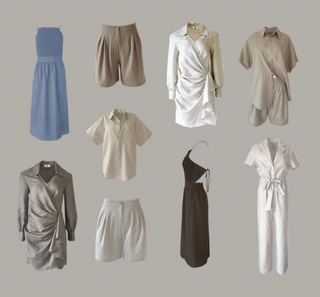As the fashion industry ventures into 2024, sustainable fashion trends are not merely a niche market but a fundamental shift towards a more responsible future. Innovations such as zero-waste production techniques and the adoption of vegan materials are setting new benchmarks for environmental and ethical standards. These advancements, coupled with the integration of digital technology for enhanced transparency and sustainability, are redefining consumer expectations and industry practices. The question that now arises is how these trends will evolve and what impact they will have on global fashion consumption and production. This discussion invites a closer examination of the transformative potential of sustainable fashion in the coming year.
Circular Fashion Models

Circular fashion models are revolutionizing the industry by promoting the reuse, repair, and recycling of clothing, thereby significantly reducing waste and extending the life cycle of garments. This innovative approach is grounded in the principles of sustainability, aiming to create a closed-loop system where materials are continually repurposed rather than discarded. By focusing on reusable designs, the fashion sector is making strides towards minimizing its environmental footprint. These designs are not only versatile and durable but also crafted to be easily updated or mended, encouraging consumers to value longevity over disposability.
Recycled textiles play a crucial role in this model, transforming waste into valuable resources. Brands are increasingly sourcing materials from pre-consumer and post-consumer waste, reducing the demand for virgin resources and decreasing the industry's overall impact on the planet. Upcycled garments further exemplify this trend, with designers creatively reimagining leftover fabrics and outdated pieces into new, desirable fashion items.
Eco-friendly practices and sustainable production methods are at the heart of circular fashion. These encompass everything from reducing water usage and energy consumption in manufacturing to employing non-toxic dyes and finishes. As the fashion industry embraces these changes, it not only meets the growing consumer demand for sustainable products but also sets a new standard for responsible fashion.
The Rise of Vegan Fashion

In recent years, the fashion industry has witnessed a significant surge in the popularity of vegan fashion, driven by growing consumer awareness of animal welfare and environmental concerns. This movement towards compassion and sustainability has given rise to a plethora of cruelty-free designs that not only refuse to compromise on style but also prioritize the planet and its inhabitants. Designers and brands are increasingly turning to plant-based textiles, showcasing that luxury and eco-consciousness can go hand in hand.
Innovative alternatives to traditional materials are at the forefront of this shift. These include fabrics derived from agricultural byproducts and recycled fibers, which offer a lower environmental footprint without the use of animal products. The market for ethical accessories has similarly expanded, with consumers demanding products that align with their values of kindness and sustainability. From handbags made of mushroom leather to shoes crafted from recycled plastics, the options for animal-friendly aesthetics are growing exponentially.
The rise of vegan fashion not only reflects a broader societal shift towards more ethical consumption but also pushes the boundaries of creativity in design. It proves that fashion can be a force for good, blending style with substance to create a more compassionate world.
Digital Fashion Innovations

Digital fashion innovations are revolutionizing the way we think about clothing consumption and design, leveraging technology to create sustainable and customizable fashion solutions. Among these, virtual try-ons are gaining traction, reducing the need for physical samples and thereby cutting down on waste. This technology allows consumers to see how garments look on them through their digital devices, leading to more satisfactory purchases and fewer returns.
Blockchain transparency is another key innovation, offering a verifiable record of a garment's lifecycle, from raw material sourcing to final production. This transparency builds trust among consumers who are increasingly concerned about the ethical credentials of their clothing.
Augmented reality showrooms offer an immersive shopping experience without the environmental cost of traditional retail spaces. Shoppers can explore collections in a virtual environment, reducing the carbon footprint associated with physical stores.
AI fashion assistants are streamlining the design and manufacturing process, predicting trends, and optimizing inventory levels to avoid overproduction.
Lastly, digital fabric printing technology permits the creation of high-quality, customizable textiles with minimal waste, using eco-friendly inks and materials. Together, these digital fashion innovations are setting the stage for a more sustainable and consumer-responsive fashion industry.
Sustainable Textile Breakthroughs

Recent advancements in sustainable textiles are transforming the fashion industry's approach to eco-friendly production and design. Innovators are increasingly turning to biodegradable textiles, which promise a future where fashion waste decomposes naturally, reducing landfill mass. These materials, derived from sources like agricultural waste, are not only eco-friendly but also promote a circular fashion economy.
Hemp innovation is making significant strides, with researchers developing new methods to soften this traditionally coarse fiber, making it a more attractive option for a wider range of garments. Its low environmental impact, requiring less water and no pesticides, underscores hemp's potential as a sustainable staple.
Sustainable synthetics are also on the rise, offering alternatives to petroleum-based fibers. These synthetics, made from recycled plastics or plant-based materials, aim to reduce dependency on fossil fuels without sacrificing the performance qualities that make traditional synthetics popular in activewear and durable clothing.
Natural dyeing methods are being revisited and refined, utilizing plant-based dyes that eliminate harmful chemicals from the production process. This practice not only reduces water pollution but also revives ancient techniques with a modern twist.
Lastly, organic fiber advancements are enhancing the sustainability of cotton and wool. By improving organic farming practices, these fibers offer a reduced environmental footprint through less water usage and the elimination of pesticides, aligning with the growing demand for cleaner, greener fashion choices.
In conclusion, the sustainable fashion trends of 2024 highlight the industry's pivotal shift towards practices that are both environmentally and ethically conscious. By embracing zero-waste production techniques, vegan fashion, circular models, digital innovations, and breakthroughs in sustainable textiles, the fashion sector demonstrates a commitment to reducing its ecological footprint and promoting sustainability.


